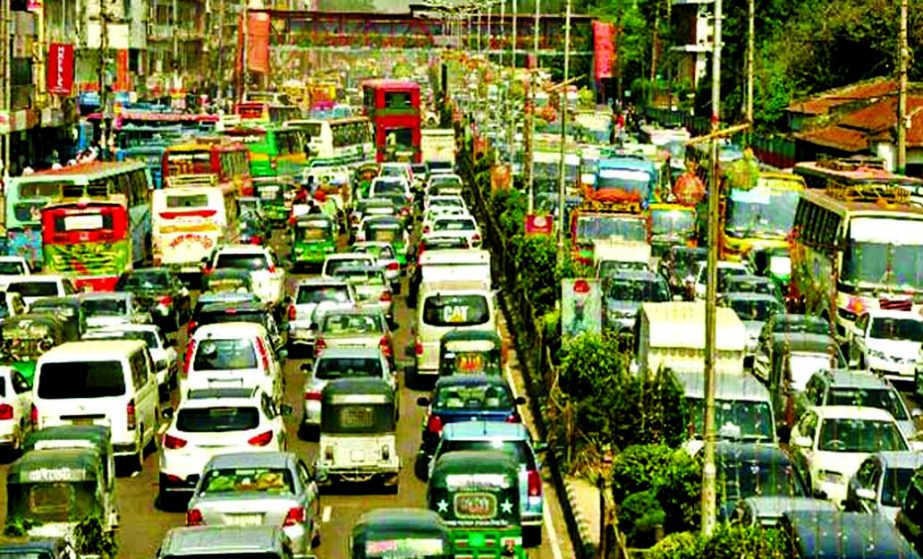
Reza Mahmud :
Residents in Dhaka city see no respite from the traffic gridlock as a result of excess number of vehicles against the streets capacity, illegal parking and poor traffic management by the authorities concerned.
Experts and the officials of the traffic department have expressed concerned over the city’s worsening traffic congestion that causing a loss of around Tk 60,000 crore every year.
“There is no sign to ease the tailback in the capital. Rather, the situation is aggravating day by day. It plagued the city with huge economic loss,” Dr. Sarwar Jahan, Professor of Urban Planning of Bangladesh University of Engineer and Technology (BUET), told The New Nation on Saturday.
Sarwar Jahan said, the private cars are the main players behind the traffic jam on the city streets. “There are more than 1.5 crore people living in Dhaka. The vehicles are increased comparatively with the growing people. But the streets are not increased further intensifying the traffic congestion,” he said.
He said, the international standard practice is that a city has to furnish with 25 per cent streets of its total size. But there are only 7 to 8 per cent of streets in our capital. Big portions of those streets are also grabbing by the illegal car parking and vendors.
The urban planner recommended quick implementation of metro-rail and expressway with the public transportations to ease the traffic gridlock.
He also stressed the need for administrative decentralization soon. “Increasing numbers of vehicles in limited road capacity is the main cause of the gridlock. The Traffic Department is finding it hard to improve the situation,” Additional Commissioner (Traffic) of Dhaka Metropolitan Police Mosleh Uddin Ahmed told The New Nation yesterday. “We have increased the number of cases filed against the illegal vehicles and drivers. Previously, we filed around two thousand cases, but now it reached four thousand everyday against the persons who violate traffic laws,” he said..
Mosleh Uddin also said that they are now arranging traffic education in different educational institutions.
According to the Traffic Department, the streets of the capital city have capability to run only 3.0 lakh vehicles. But around 9.0 lakh vehicles are being registered with the Bangladesh Roads and Transport Authority (BRTA).
The actual number of vehicles could even more than the figure, he said, adding there were around 5.0 lakh vehicles in the city in 2009. Besides, there are around 12 lakh rickshaws running while the licensed number of these vehicles is only 79,000.
Experts said, around 3.0 lakh private cars run on the city streets everyday. The huge number of cars carried very few people. The uneducated drivers are also the big cause to increase gridlock, they said..
Stakeholders said, public buses stopped here and there to pull passengers outside of the bus stands are also a big cause of gridlock.
The most important points in the city like Farmgate, New Market, Science Lab, Mohakhali, Rampura, Badda, Gulistan, Syedabad and Jatrabari areas are seen full of gridlock in everyday for the reckless passenger pulling by the buses.
On the other hand, the illegal car parking in roadside is the major cause of unbearable gridlock.
“You see, lot of cars and big sizes microbuses were parked by dominated huge portions of streets in Motijheel area. A narrow portion only is open for the running vehicles in whole Motijheel and Dilkusha commercial area.
It causes inevitable traffic gridlock and untold suffering to the passengers.
But the authority seemed undone to curb the situation,” said Abdul Hakim, a bus driver at Motijheel.
But the traffic officials said they frequently conduct operations to hold the cars and fine their owners and even filing cases but the situation remains the same.
Traffic officials said, without creating consciousness among the car owners, it is difficult to make the streets free from illegal parking.
According to the Traffic Department, there are around four thousand traffic officials’ works in more than 600 traffic signal points everyday. Around 20 per cent of them are in vacations most of the time.
The rest 80 per cent of the officials faced difficulties to control the huge vehicles.
“Before understanding the problems of the traffic system and way to curb that, the officials were transferred to other offices.
It is the major cause to remain the traffic department comparatively inexpert. So, the higher traffic officials should stay for long term in their posts,” said an official preferring anonymity.
Mayors of the two city corporations of the capital are also trying to improve the situation by using their own tools like removing big bus and truck stands out side of the capital.

